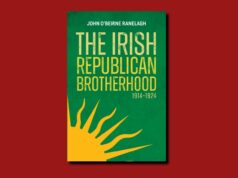
After the Silence
by Louise O’Neill | riverrun | €12.99 pb | 448pp | 9781784298906
review by Joanne O’Sullivan
“ … credible and captivating, a novel reflective of the contradictions and injustices women and victims of abuse encounter on a regular basis … “
After the Silence is a dark and intricate story of the lies we can live, and the fatal effects of long-held secrets. Keelin Kinsellsa and her husband Henry live an enviable life in “the big house” on the island of Inisrún. The owners of a chic international artists’ retreat that attracts celebrities and artists to the island, they lead a seemingly perfect life of privilege and parties. The night they host a party for Keelin’s birthday, a huge storm hits Inisrún and ensures that no one can enter or leave the island. As the sun comes up the next day, teenager Nessa Crowley is found dead outside the house and all eyes are on the Kinsellas. 10 years later, two documentary filmmakers arrive to investigate the unsolved murder of the most alluring of the infamous Crowlely sisters, and the Kinsella family’s connection to her death.
Since that night, Henry and Keelin have been shunned by the islanders and Keelin’s world has grown smaller and more isolated than ever before. Keelin was born on Inisrún, and enjoyed an idyllic and sheltered childhood with her small circle of family and friends. As an adult, her life became darker and more difficult. Her first husband inflicted terrible physical abuse throughout their marriage, until she escaped back to the small island community with her son Alex. Following the death of her parents, she begins a relationship with Henry Kinsella – son of the infamous Kinsella family who have brought prosperity to Inisrún. While her first marriage highlights the more apparent examples of domestic abuse, her second husband is far from perfect.
After the Silence is a novel about the insidious, hidden nature of some acts of abuse and control. While her friends and family initially see Keelin’s new marriage as positive and safe, Keelin eventually finds herself isolated from close friends and the victim of coercive control and gaslighting. The story challenges the stereotype that there is one type of victim in abusive relationships, as Keelin is a resilient and impressive woman who has trained as a counselor. When the documentary filmmakers arrive, a spotlight is cast on both her marriage and her family. Keelin strikes up an unlikely friendship with one of the filmmakers, and does everything in her power to protect Henry and Alex from the consequences of the true events of that night.
While the primary focus of After the Silence is the mystery of Nessa Crowley’s murder, O’Neill also finds time to emphasise the uneasy relations that can exist in rural Ireland between locals and “blow-ins”. It’s a topic extremely exposed to the dangers of being exaggerated, or misunderstood by a contemporary reader; but she succeeds in making this difficult dynamic a believable backdrop for the story. Henry’s mother was born on Inisrún, but having grown up in a privileged British family Henry has a complicated relationship with the island and Ireland. His family’s establishment of the artists’ retreat and commercialisation of the island’s heritage for tourism creates an uncomfortable power dynamic between the Kinsella family and the islanders. The reluctantly reliant relationship leads to deep rooted resentments that reinforce the locals’ suspicions of Henry and Keelin in the murder of Nessa.
It can be hard to unravel all of the topics that O’Neill takes issue with; ranging from the horrifying examples of emotional and physical abuse, to the nuanced portrayals of personal tensions and the unfair expectations women face. But that’s simply reflective of the contradictions and injustices women and victims of abuse do encounter on a regular basis, and however complex or difficult it becomes to contend with, it’s impossible to read the novel and claim it’s depictions are anything but genuine. Throughout the novel, the clear sense of responsibility O’Neill feels towards representing all forms of abuse and all types of victims authentically is obvious and admirable. The book’s bibliography, author’s notes and list of interviewees indicate the detailed research that has gone into putting together a story that is both credible and captivating.
***
Joanne O’Sullivan presents All About Books for Dublin City FM (103.2),
a weekly dive into the world of books and publishing.
@JoanneKateOS












